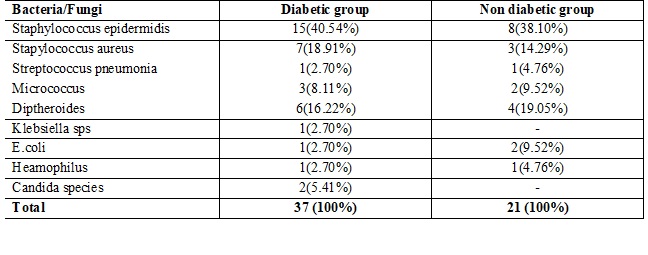Significance of normal conjunctival flora in diabetic versus healthy individuals
Abstract
Introduction: Conjunctival sac is constantly exposed to theenvironment. It is more prone to colonization with various microorganisms, which are considered as normal ocular flora. The conjunctival flora in diabetic subjects may differ from that in the nondiabetic subjects. Hence the present study was conducted to determine the flora of conjunctiva in diabetic patients and non diabetics.
Materials and Methods: A total of 100 patients were enrolled in the study. On the basis of history and glycemic status, 55 patients were included in the diabetic group and another 45 patients were included in thenon-diabetic group. Conjunctival swabs were collected and inoculated on bacteriological media (blood agar and chocolate agar) and mycological media (Sabourauddextrose agar). Inoculated bacteriological (37o C) and mycological media (25o C) were incubated for 48 hours and 2-4 weeks respectively and microbial colonies were identified after isolation as per standard microbiological procedures.
Results: Microbial growth yielded from the conjunctival swabs in the diabetic patients was 67.27% and in the non diabetic individuals it was 46.67% .The most common isolated bacteria in diabeticand non diabetic groups was Staphylococcus epidermidis, which accounted for 40.54% and 38.10% respectively. S.aureus was the second most common organism which accounted for 18.91% in diabetics and 14.29% in non diabetics. Candida species was isolated in diabetic group, but not from non diabetic group.
Conclusion: It is essential to differentiate the conjunctival microbial flora in normal healthy individuals and patients who are undergoing ocular surgery. The presence of microbial pathogen leads to an idea of microbial flora and antimicrobial susceptibility tests, which helps in the preoperative and post operative antimicrobial prophylactic therapy.
Downloads
References
2. Najmun Nahar, RiponBaura, Sultana Razia, Shaheda Anwar, Md. Ruhul Amin Miah.. Conjuctival Bacterial flora in healthy individuals and health care workers. (HCWs+). Bangladesh J Med Microbiol 2012;06(2):15-19.
3. Jawetz E, Melnnick LJ, Adelberg AE, et al.Medical Microbiology 18th Ed, Prentice Hall I International, USA. 1989: 18: 275-8.
4. Adam M, Balcı M, Bayhan HA, et al. Conjunctival Flora in Diabetic and Nondiabetic Individuals. Turk J Ophthalmol. 2015 Oct;45(5):193-196. Epub 2015 Oct 5.[pubmed]
5. Skarbez K, Priestley Y, Hoepf M, et al. Comprehensive Review of the Effects of Diabetes on Ocular Health. Expert Rev Ophthalmol. 2010 Aug 1;5(4):557-577.[pubmed]
6. Martins EN, Alvarenga LS, Höfling-Lima AL, et al. Aerobic bacterial conjunctival flora in diabetic patients. Cornea. 2004 Mar;23(2):136-42.[pubmed]
7. Karimsab D, Razak SK. Study of aerobic bacterial conjunctival flora in patients with diabetes mellitus. Nepal J Ophthalmol. 2013 Jan-Jun;5(1):28-32. doi: http://dx.doi.org/10.3126/nepjoph.v5i1.7818.[pubmed]
8. Kalpana Suresh, KrishnajaMandava, Anupma Jyoti Kindo. Conjunctival Flora In Diabetics & Normal Population - A Comparative Study.2014;7(2):1-4.
9. Bilen H, Ates O, Astam N, et al. Conjunctival flora in patients with type 1 or type 2 diabetes mellitus. Adv Ther. 2007 Sep-Oct;24(5):1028-35.[pubmed]
10. Suto C, Morinaga M, Yagi T, et al. Conjunctival sac bacterial flora isolated prior to cataract surgery. Infect Drug Resist. 2012;5:37-41. doi: 10.2147/IDR.S27937. Epub 2012 Jan 24.[pubmed]
11. Puliafito CA, Baker AS, Haaf J, et al. Infectious endophthalmitis. Review of 36 cases. Ophthalmology. 1982 Aug;89(8):921-9.[pubmed]
12. Phillips WB 2nd, Tasman WS. Postoperative endophthalmitis in association with diabetes mellitus. Ophthalmology. 1994 Mar;101(3):508-18.[pubmed]
13. Rao PN, Rao KN. Study of the normal conjunctival flora (bacterial and fungal) and its relations to external ocular infections. Indian J Ophthalmol. 1972 Dec;20(4):164-70.[pubmed]
14. Nema HV, Mathur JS, Thakur V. Mycotic flora of trachomatous conjunctiva. Indian J Ophthalmol. 1976 Jul;24(2):9-11.[pubmed]
15. Arbab TM, Qadee S, Iqbal S, Mirza MA. Aerobic bacterial conjunctival flora in diabetic Patients. Pak J Ophthalmol. 2010;26(4):177-181.

Copyright (c) 2019 Author (s). Published by Siddharth Health Research and Social Welfare Society

This work is licensed under a Creative Commons Attribution 4.0 International License.


 OAI - Open Archives Initiative
OAI - Open Archives Initiative



















 Therapoid
Therapoid

